Cardiovascular health awareness,risk perception,behavioural intention and INTERHEART risk stratification among middle-aged adults in Malaysia
Siew-Keah Lee ,Ang-Lim Chua ,Clement Heng Yew Fong ,Ban Hao Brian Cong ,Wen Ling Ng ,Jing Feng Kong ,Yik-Ling Chew,Kai Bin Liew,Yang Shao,5✉
1M.Kandiah Faculty of Medicine and Health Sciences, Universiti Tunku Abdul Rahman, Malaysia
2Faculty of Medicine, Universiti Teknologi MARA, Malaysia
3Faculty of Pharmaceutical Sciences, UCSI University, Malaysia
4Faculty of Pharmacy, University of Cyberjaya, Malaysia
5The First Affiliated Hospital of Hainan Medical University, China
ABSTRACT Objective:To investigate the interrelationship between cardiovascular health awareness,risk perception,behavioural intention,and INTERHEART risk stratification in a middle-aged adult population in Malaysia.Methods:A cross-sectional survey with convenience sampling was conducted during November 2022 and January 2023.Participants completed validated questionnaires assessing cardiovascular health awareness,risk perception of cardiovascular diseases,behavioural intention towards adopting healthy habits,and INTERHEART risk stratification score (IHRS) based on established risk factors.A total of 602 respondents were included in the final analysis.Data were analysed with independent t-test/one-way ANOVA or Mann-Whitney/Kruskal-Wallis to test the differences,Pearson correlation or linear regression test to analyze the association of independent and dependent variables.Results:There was a significant positive correlation between medical knowledge related to cardiovascular disease (CVD)and knowledge related to CVD risk prevention,risk perception,behavioural intention and IHRS (P<0.05,Pearson correlation).Notably,individuals with higher IHRS tended to have lower knowledge related to CVD and CVD risk prevention,risk perception,and behavioural intention.Males,laborers,active/former smokers,individuals with lower household income and educational levels,those involved in occupations not related to the healthcare sector,and those who did not receive the CVD health brochure or are unaware of health self-assessment tools are likely to have lower levels of knowledge,risk perception,and poorer behavioural intention regarding cardiovascular health (P<0.05,one-way ANOVA).While educational level,smoking status,awareness about CVD poster,self-assessment tools were repeatedly significantly associated with knowledge related to CVD and CVD risk prevention,risk perception,behavioral intention and/or IHRS (P<0.05,linear regression).Conclusions:These findings underscore the importance of promoting cardiovascular health awareness and risk perception among middle-aged adults to foster positive BI and reduce CVD risk.Tailored interventions targeting specific risk factors identified by INTERHEART may enhance risk stratification accuracy and facilitate targeted preventive strategies.
KEYWORDS: Cardiovascular risk;Knowledge;Risk perception;Behavioural intention;INTERHEART;Middle-aged;Lifestyle;Physical activity;Psychosocial stress
1.Introduction
Cardiovascular disease (CVD) is a leading cause of mortality and morbidity worldwide,including Malaysia,where the burden of these conditions is particularly significant among middle-aged adults[1].With advancing age,physiological changes occur within the cardiovascular system,coupled with the cumulative impact of risk factors that may have been present over time,the middleaged population faces a higher risk of CVD.In addition,unhealthy lifestyle habits,such as poor dietary choices,sedentary behaviour,and chronic stress,often take root during busy and stressful middleaged life stages,further exacerbating CVD risk.Hormonal changes,particularly in women during menopause,can also influence cardiovascular health[2,3].
CVD encompasses a range of conditions which include coronary artery disease,myocardial infarction,stroke,heart failureetc.The major risk factors associated with development of CVD include age,sex,family history,hypertension,hypercholesterolaemia,diabetes,uses of tobacco/smoking,obesity,physical inactivity,unhealthy diet,stress[2,3].These risk factors are incorporated into various established CVD event prediction tools like the Framingham risk score,Atherosclerotic Cardiovascular Disease (ASCVD) risk estimator,QRESEARCH cardiovascular risk algorithm (QRISK) and Systematic Coronary Risk Evaluation (SCORE) algorithm[4].While INTERHEART risk stratification emerges as a highly advantageous and practical approach,particularly well-suited for individuals with limited resources or those operating in settings with inadequate laboratory facilities[5].As development of CVD is very closely associated with modifiable risk factors,certainly,the awareness of CVD risk factors and the adoption of preventive behaviours are important for reducing the incidence and burden of the disease[6,7].By fostering a deep understanding of the risks associated with unhealthy lifestyle choices and encouraging proactive measures,individuals can make informed decisions and take actions to mitigate their CVD risks.Engaging in regular physical activity,adopting a healthy diet,refraining from tobacco use,managing stress levels,and maintaining optimal blood pressure and cholesterol levels are all fundamental components of preventive behaviours.By embracing these lifestyle modifications,individuals can significantly reduce their chances of developing CVD and promote overall cardiovascular well-being[1,3,6,7].
Social determinants of health encompass a wide array of nonmedical elements that significantly impact health outcomes which include the circumstances under which individuals are born,raised,employed,reside,and age,along with the influence of economic policies,developmental strategies,social norms,and political systems[3].Recognizing their pivotal role,these determinants profoundly influence the development of CVD risk factors,as well as the morbidity and mortality associated with CVD.Research has consistently demonstrated that awareness of behavioural risks constitutes a pivotal catalyst for embracing lifestyle modifications.Individuals who possess a heightened perception of their vulnerability to CVD are significantly more inclined to adopt healthier lifestyle practices[8,9].
There have been several previous studies examining the association or/and degree of knowledge,attitude,and practice towards CVD risk and prevention among adults in Malaysia[10-12].However,these studies did not project the associations of knowledge and risk perception onto any established CVD risk scores.As such,comprehensive assessment and understanding of knowledge levels,risk perception,and intention towards adopting a heart-healthy lifestyle,and individuals’ CVD risk score assume paramount importance in crafting effective and precisely targeted public health interventions.By gaining insights into these crucial factors,policymakers and healthcare professionals can tailor interventions that resonate with the specific needs and motivations of the population,ultimately fostering sustainable behavioural changes and reducing the burden of CVD in the community.Therefore,the study aims to explore the dynamic interplay between cardiovascular health awareness,risk perception,behavioural intention,and the INTERHEART risk stratification among middle-aged adults in Malaysia.
2.Subjects and methods
2.1.Ethical clearance
The study received approval from the Institutional Scientific and Ethical Review Committee (U/SERC/236/2022),and all research procedures were conducted in strict adherence to the established code of ethics.
2.2.Study design and sample size calculation
This survey was conducted between November 2022 and January 2023.In this study,a cross-sectional design was employed;convenience sampling and snowball sampling was utilized to recruit participants who were readily available and willing to participate in the study.
The sample size required for this study was calculated using the Cochran’s formula as shown as below:
whereby:
n=sample size
Z=statistic for confidence level of 95% (standard value of 1.96)
P=expected prevalence
D=margin of error (5% with a standard value of 0.05)
Hypercholesterolemia holds the highest prevalence rate among all other risk factors for CVD at 38.1%[13];and it served as the basis for calculating the sample size.The calculated sample size was 363,after incorporating a 20% non-response rate into the initially calculated sample size,the adjusted minimum sample size required was 436 individuals.
2.3.Participation eligibility
Inclusion criteria: Eligible participants with age of 40 to 60 years old,who reside in Malaysia,and understand English,Bahasa Malaysia or Chinese (Simplified) were recruited for survey participation.
Exclusion criteria: Individual below the age of 40 or over 60 were deemed ineligible for participation,and participants who could not read or comprehend English,Bahasa Malaysia or Chinese(Simplified) were excluded to ensure effective communication and understanding of survey content.
2.4.Survey instrument preparation and validation
The questionnaire was initially prepared in English and was then translated into Bahasa Malaysia and Chinese (Simplified) using a forward and backward translation technique to ensure linguistic equivalence.
This survey tool assessed sociodemographic characteristics,medical knowledge related to CVD (K1),knowledge related to CVD risk prevention (K2),risk perception (RP),behavioural intention(BI) towards CVD risk prevention,and INTERHEART CVD risk stratification (IHRS) among middle-aged adults in Malaysia.
A preliminary study was conducted involving 30 participants who completed the questionnaire.The results of this study demonstrated a high level of internal consistency,as indicated by Cronbach's alpha values exceeding 0.8.All data obtained from the preliminary study were excluded from the final data analysis to maintain the integrity and independence of the actual data collected for the main study.
2.5.Survey invitation and informed consent
Physical copies of the questionnaire were distributed among the public using convenience sampling,and the completed questionnaires were collected on the same day they were distributed.Simultaneously,an online version of the questionnaire was shared with personal contacts through E-mails,and mobile messenger apps.Additionally,the same invitation was posted on various online social media platforms to encourage public participation.Participants were encouraged to share the invitation with their own contacts.
Prior to participating in the study,all respondents were requested to provide informed consent.It was made clear that their participation was voluntary,and they had the right to withdraw from the study at any time by discontinuing their participation and ceasing to answer the questions.
2.6.Knowledge, risk perception, behavioural intention outcome measures
For the knowledge measures,participants were awarded 1 point for each correct answer,while incorrect or "I do not know" responses received 0 points.In the case of risk perception and behavioural intention measures,a five-point Likert scale ranging from "strongly disagree" to "strongly agree" was utilized.The poorest risk perception or behavioural intention was assigned 0 points,followed by 1,2,3,and 4 points for increasingly favourable risk perception or intention to change.The obtained points were converted to a percentage using the formula: (points obtained/total points) ×100%.This scoring method allowed for the quantification statistical analysis of participants' knowledge,risk perception,behavioural intention.
2.7.Computational of INTERHEART risk score
Respondents were required to self-assess their health status using a series of questions related to INTERHEART score evaluation as described in our previous study[14].This scoring system was developed based on various risk factors associated with CVD.The risk factors included age and sex,family history of heart attack,smoking status,second-hand smoke exposure,diabetes mellitus status,hypertension status,waist-hip ratio,psychosocial stress level,depression,dietary habits,and physical activity status.For each positive risk factor identified,a specific score was assigned to reflect its contribution to the overall risk assessment.The cumulative scores ranged from 0 to 48,with higher scores indicating a greater risk of developing CVD.Respondents with scores between 0 and 9 were categorized as low risk,scores between 10 and 15 as moderate risk,and scores between 16 and 48 as high risk[5].
2.8.Statistical analysis
The statistical analysis was conducted using SPSS version 22.0.Categorical data were presented as frequencies and percentages,while continuous data were presented as means and standard deviations (mean±SD).One-way ANOVA or Kruskal-Wallis followed by post hoc or independentt-test or Mann-Whitney was used to test the difference of the means/medians of independent groups.Linear regression was used to determine the factors associated with K1,K2,RP,BI and IHRS mean scores.Pearson correlation test was used to test the correlation of two continuous variables.Statistical significance was determined by aP-value of less than 0.05.
3.Results
A total of 602 respondents were recruited for this study,with 40%being males (n=241) and 60% being females (n=361).The mean age of the respondents is (49±6) years old.
The mean score of medical knowledge related to CVD (K1) was(79.4±21.9)% (upper moderate),while mean score for knowledge towards prevention of CVD risk (K2) was (90.1±18.6)% (upper good).The risk perception (RP) score was (83.2±12.8)% (lower good);while the behavioral intention is the lowest among these scores,which is 79.9% (upper moderate) (Tables 1-5).Merely 46% of the middle-aged adults strongly agreed that risk factor modification can prevent CVD (Table 4),and only 32.6% of them strongly agreed to have the intention to change their behavioural risks (Table 5).

Table 1.Average scores of K1,K2,RP and BI (%).
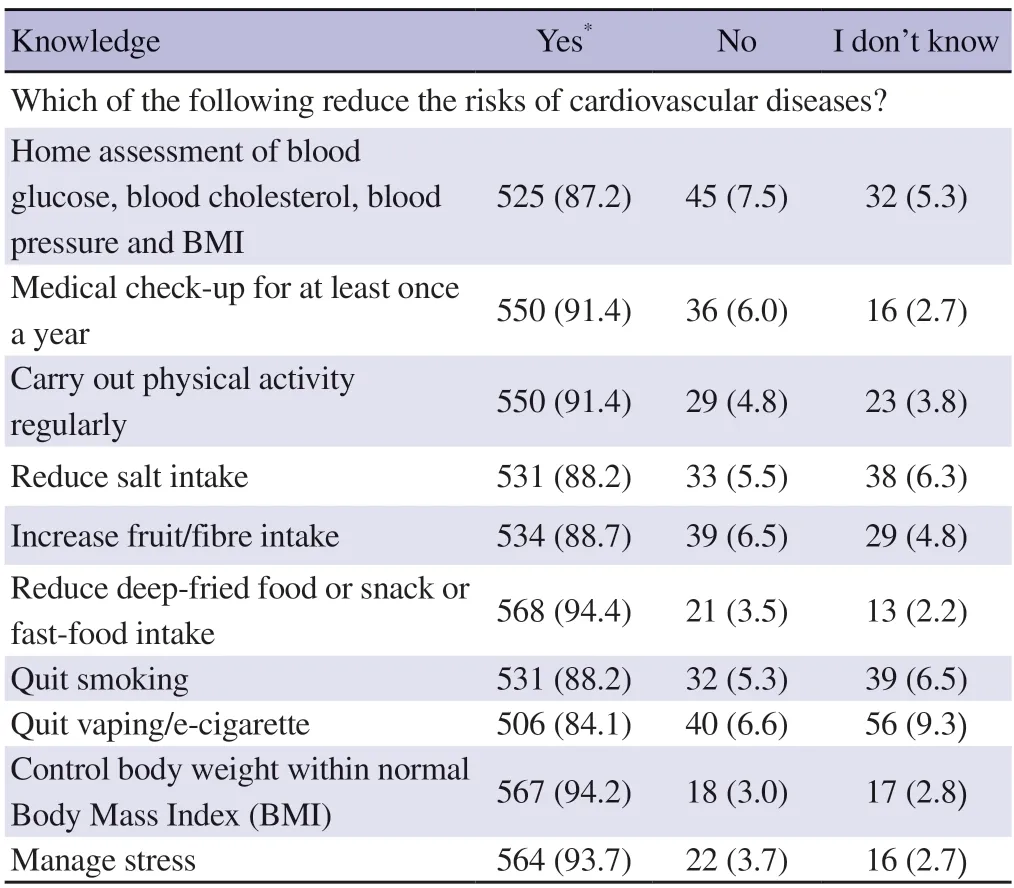
Table 3.Knowledge towards prevention of CVDs risks (K2) [n (%)].
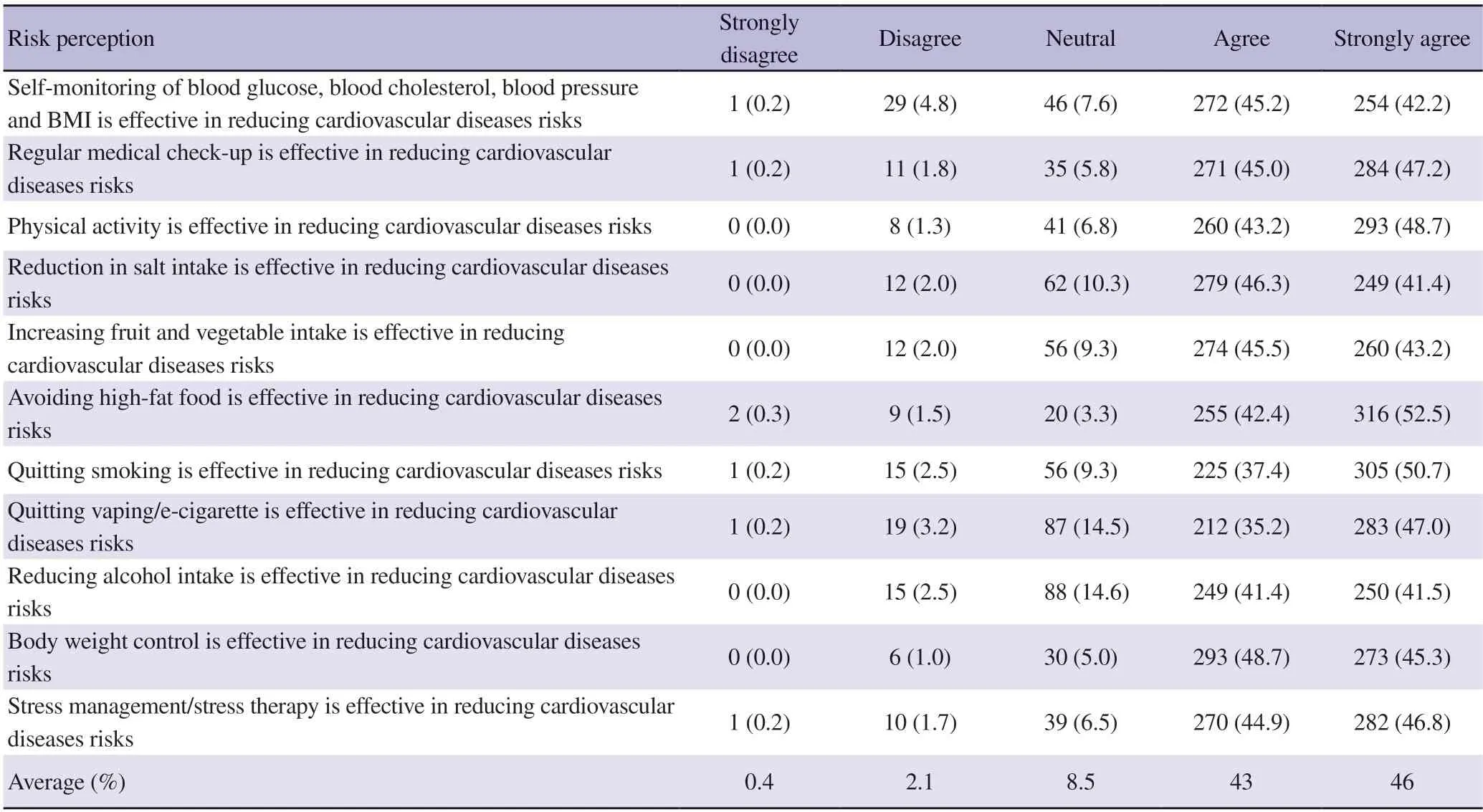
Table 4.Risk perception towards prevention of cardiovascular diseases risks [n (%)].
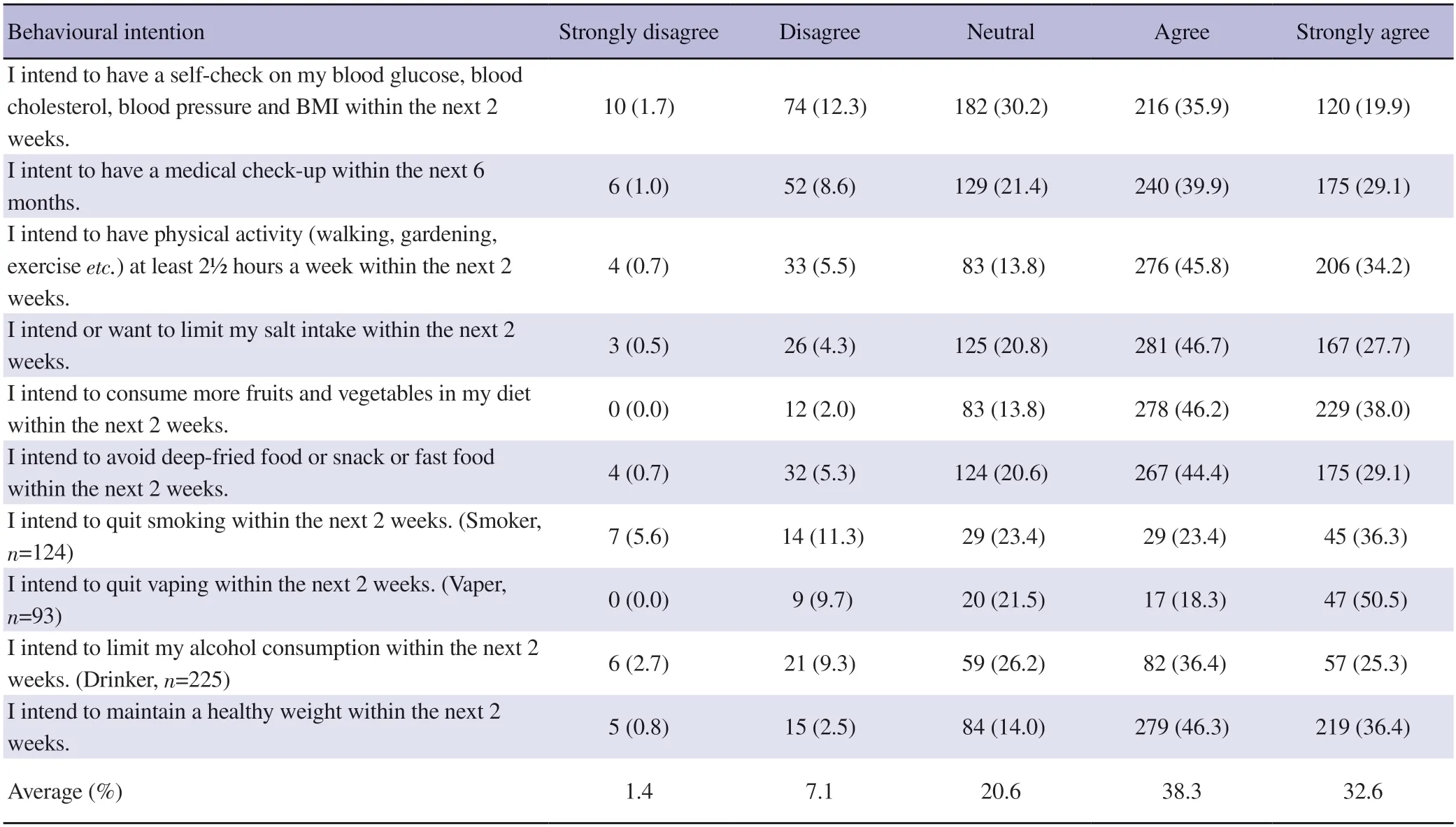
Table 5.Behavioural intention [n (%)].
Bloom’s cut off points are adopted to categorise K1,KAP and I score into upper good (90%-100%),lower good (80%-89%),upper moderate (70%-79%),lower moderate (60%-69%) and poor (less than 60%).Data were expressed as mean ± SD.CVD: Cardiovascular diseases.
Pearson correlation tests reveal that INTERHEART risk scores are inversely correlated with knowledge levels,risk perception,and behavioral intention scores (Table 6).

Table 6.Correlation between K1,K2,RP,BI and IHRS.
Table 7 showed that males,labors,active/former smokers,lower household incomes,occupation not related to health care,lower educational level,those did not aware about CVD self-assessment test,those did not receive information brochure related to CVD prevention have lower degree of K1 or/and K2.Furthermore,the knowledge level of those in the high-risk IHRS category is significantly lower than that of their counterparts.
Labor workers,active/former smokers,and those with lower household incomes,occupation not related to health care,lower education level,those did not aware about CVD self-assessment test,did not receive information brochure related to CVD prevention,tend to have poorer risk perception towards CVD prevention (Table 7).
While males,those with lower educational level,active smokers,those did not aware about CVD self-assessment test,those did not receive information brochure related to CVD prevention tend to have poorer behavioral intention (Table 7).
The relationship of sociodemographic factors and IHRS scores has been published in our previous study[14].Briefly,older age,males,labors,those with lower educational level,active/former smokers,did not aware about CVD self-assessment tool,did not undergo routine medical check-ups tend to have higher IHRS risk scores(Table 7).
Table 8 shows the factors/interactions associated with K1,K2,RP,BI and IHRS mean scores.Regression tests revealed that age,gender,BMI,health-care related occupation,smoking status,educational level,medical history (family history of heart attack,diabetes,hypercholesteremia,hypertension),exposure to CVD informative poster/brochure,aware of self-assessment tools are the relevant important determinants for with K1,K2,RP,BI and/or IHRS mean scores.While educational level,smoking status,awareness about CVD poster,self-assessment tools were repeatedly significantly associated with K1,K2,RP,BI,or/and IHRS.
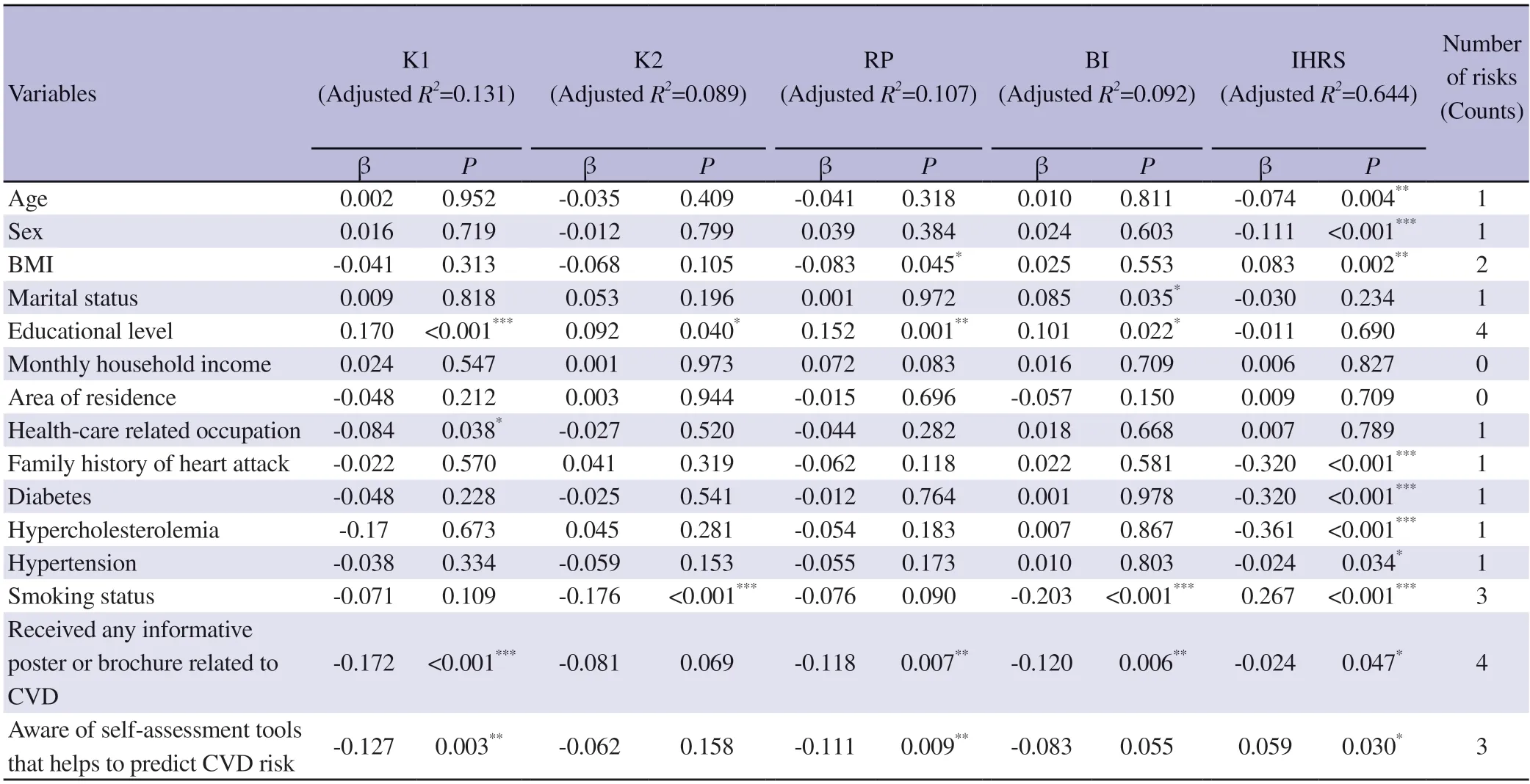
Table 8.Factors associated with K1,K2,RP,BI and IHRS mean scores.
4.Discussion
The results revealed a significant positive correlation between cardiovascular health awareness,risk perception and behavioural intention.Notably,individuals with higher INTERHEART riskstratification scores tended to have lower cardiovascular health awareness,risk perception,and behavioural intention.While educational attainment through formal education or exposure to informative posters related to CVD is associated with awareness of CVD risk,self-assessment tools are predominantly linked to levels of knowledge,risk perception,behavioral intention,and IHRS scores.This observation mirrors findings from parallel research in other Asian countries,such as China and India[6,9,15].
The findings of this study provide evidence that the knowledge gap regarding CVD risk and prevention is intrinsically linked to individuals’ risk scores,as well as risk perception and behavioural intention.This study sheds light on the crucial relationship between knowledge and health outcomes,highlighting that a lack of understanding about CVD risk factors can directly impact an individuals’ overall risk profile.These findings emphasize the importance of disseminating accurate and comprehensive information about CVD prevention and risk management,as it can play a crucial role in mitigating the burden of cardiovascular diseases on public health.The findings of the survey highlight several knowledge gaps related to CVD among specific demographic groups.The following groups have shown lower levels of knowledge compared to their counterparts: (1) males,(2) labour workers,(3)active/former smokers,(4) individuals with lower income,(5) those whose occupation is not related to healthcare,(6) individuals whoare not aware of CVD risk self-assessment tools or (7) who have not received information brochures related to CVD prevention.Further regression analysis showed that healthcare related occupation,smoking status,educational level,exposure to CVD self-assessment tool,and information are the predictors for knowledge levels.
Males appear to have a lower level of knowledge about CVD compared to females.This gender disparity could be attributed to differences in health-seeking behaviour or societal norms[8,16].Recent studies have shown that health literacy concerning hypertension prevention,healthy living[17] and health self-assessment tools[18]is lower among males in Malaysia.Underserved individualse.g.labours,those with lower income,low educational levels may face challenges in seeking preventive caree.g.health screening,and they may have limited access to health information and resources,as their work environments may not prioritize health promotion,leading to a lack of awareness about CVD and its risk factors[3,7].Community-based initiatives,affordable healthcare options,and targeted educational programs should be developed to ensure these individuals have equal access to accurate and relevant CVD information.
The findings of this study indicate that individuals with poor risk perception,and behavioural intention are at a higher CVD risk.Educational level,exposure to CVD informative poster/brochure,aware of self-assessment tools serve as the determinants in affecting risk perception and behavioural intention.The implications of this discovery underscore the critical role that one's perception of risk and behavioural choices play in determining their susceptibility to CVD.In overall,merely 46.0% of the middle-aged adults strongly agreed that risk factor modification can prevent CVD,and only 32.6% of them strongly agreed to have the intention to change their behavioural risks.This finding highlights an important area of concern in terms of mindsets towards CVD prevention among this specific demographic.In addition,the findings of the survey reveal a surprising trend where merely 19.9% of the respondents strongly agreed to check their blood glucose,blood pressure,and BMI within the next 2 weeks.In addition,the intention to adopt crucial lifestyle changes such as increasing physical activity,modifying dietary style,quitting smoking,or reducing alcohol consumption or having regular medical check-up is notably weak among the respondents,whereby less than 40% of the participants demonstrated a strong agreement with each of these essential categories.These results indicate a concerning lack of proactive behaviour towards monitoring and assessing important health indicators among the surveyed middleaged population,and the findings are in accordance with our previous findings[17,18].
One possible explanation for this result could be a lack of awareness and understanding about the relationship between risk factor modification and CVD prevention.It is possible that respondents may not have received sufficient education or information about the impact of lifestyle choices on cardiovascular health.This knowledge gap could contribute to their hesitation or disagreement with the idea that modifying risk factors can effectively prevent CVDs[6,7].Future public health campaigns should take into account the specific societal factors that influence risk perception towards health and disease prevention.In addition,healthcare providers play a vital role in shaping attitudes and beliefs about CVD prevention.They can provide evidence-based information,engage in patient education,and emphasize the importance of risk factor modification.By fostering a strong patient-provider relationship and promoting preventive strategies,healthcare professionals can help bridge the gap between knowledge,risk perception,behavioural intention towards CVD prevention among middle-aged population.
Further research is also warranted to explore the underlying reasons behind the lack of strong agreement with risk factor modification for CVD prevention.Qualitative studies or follow-up surveys could delve deeper into understanding the specific barriers or misconceptions that contribute to these poor risk perception and behavioural intention.This knowledge can inform the development of more effective interventions and strategies to promote CVD prevention among middle-aged population in Malaysia.
This study adopted a non-randomized sampling method,which may introduce selection bias,potentially leading to overrepresentation or underrepresentation of certain population segments in the sample.As a consequence,the generalizability of the results could be limited,and making broader inferences may prove challenging.Nevertheless,it is crucial to highlight that the findings of this study yield valuable initial insights and contribute to the formulation of further research hypotheses.This enables researchers to develop a more comprehensive understanding of the phenomenon before undertaking more rigorous investigations.While acknowledging the inherent limitations of the non-randomized approach,the study's significance lies in its capacity to lay a robust foundation for future research,advancing our comprehension of the subject matter and paving the way for more exhaustive and conclusive studies.
In conclusion,individuals with higher INTERHEART risk stratification scores tended to have lower cardiovascular health awareness,risk perception,and behavioural intention.Males,laborers,active/former smokers,individuals with lower household income and educational levels,those involved in occupations not related to the healthcare sector,and those who did not receive the CVD health brochure or are unaware of health self-assessment tools are likely to have lower levels of knowledge,risk perception,and poorer behavioural intention regarding cardiovascular health.While educational level,smoking status,awareness about CVD poster,self-assessment tools were repeatedly significantly associated with K1,K2,RP,BI,or/and IHRS.Overall,the survey findings suggest a need for targeted efforts to raise awareness,improve health literacy,and foster positive attitudes towards risk factor modification as an effective means of preventing CVDs.By addressing these challenges,it is possible to empower individuals to take control of their cardiovascular health and reduce the burden of CVDs in Malaysia.
Conflict of interest statement
The authors declare that there is no conflict of interest.
Funding
This work was supported by the Ministry of Higher Education(MOHE),Malaysia,through Fundamental Research Grant Scheme(FRGS/1/2022/SKK10/UTAR/02/1),Universiti Tunku Abdul Rahman,Malaysia,through UTAR-Research Grant (IPSR/RMC/UTARRF/2021-C2/L08),and MBBS Community Health Project(2022/2023),UTAR.
Authors’contributions
LSK,CAL,CFHY,BCHB,NWL,KJF,YS developed the theoretical formalism,performed the analytic calculations and performed the numerical simulations.LSK and CAL drafted the manuscript.LKB and CYL contributed to the final version of the manuscript.
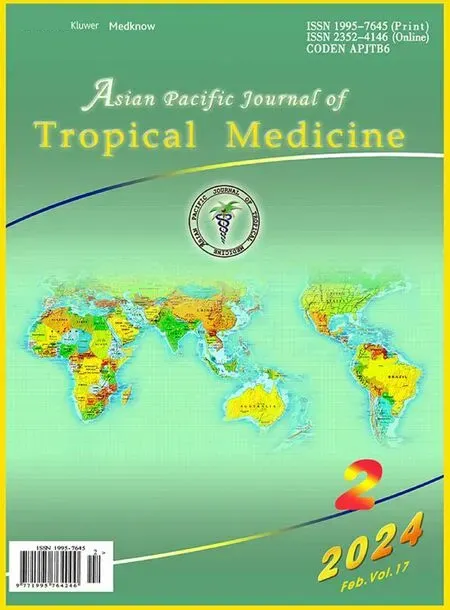 Asian Pacific Journal of Tropical Medicine2024年2期
Asian Pacific Journal of Tropical Medicine2024年2期
- Asian Pacific Journal of Tropical Medicine的其它文章
- Liposomal dual delivery systems in visceral leishmaniasis enhance the synergistic effects of combination therapy: A promise for the future
- Prevalence and intensity of urinary schistosomiasis and soil-transmitted helminths among women of reproductive age in Mwaluphamba,Kwale
- Genetic diversity of the S-type small subunit ribosomal RNA gene of Plasmodium knowlesi isolates from Sabah,Malaysian Borneo and Peninsular Malaysia
- Bilateral adrenal histoplasmosis in a Malaysian tertiary hospital: Report of four cases
